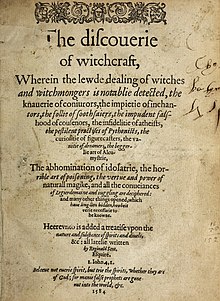The Discoverie of Witchcraft
 Title page of the first edition (1584) | |
| Author | Reginald Scot |
|---|---|
| Country | England |
| Language | English |
| Published | 1584 |
The Discoverie of Witchcraft is a book published by the English gentleman Reginald Scot in 1584, intended as an exposé of early modern witchcraft. It contains a small section intended to show how the public was fooled by charlatans, which is considered the first published material on illusionary or stage magic.
Scot believed that the prosecution of those accused of witchcraft was irrational and not
Publication
Scot's book appeared entitled "The Discoverie of Witchcraft, wherein the Lewde dealing of Witches and Witchmongers is notablie detected, in sixteen books ... whereunto is added a Treatise upon the Nature and Substance of Spirits and Devils", 1584. At the end of the volume the printer gives his name as William Brome.
There are four dedications: to
. But Scot's information was not only from books. He had studied superstitions respecting witchcraft in courts of law in country districts, where the prosecution of witches was unceasing, and in village life, where the belief in witchcraft flourished in many forms.
He set himself to prove that the belief in witchcraft and magic was rejected by reason and by religion and that spiritualistic manifestations were wilful impostures or illusions due to mental disturbance in the observers. His aim was to prevent the persecution of poor, aged, and simple persons, who were popularly credited with being witches. The maintenance of the superstition he blamed largely on the
Of
Influence
The Discoverie of Witchcraft and
Controversy
The debate over the contested Christian doctrine continued for the following decades. Gabriel Harvey, in his Pierce's Supererogation (1593),[8] wrote:
Scotte's discoovery of Witchcraft dismasketh sundry egregious impostures, and in certaine principall chapters, and speciall passages, hitteth the nayle on the head with a witnesse; howsoever I could have wished he had either dealt somewhat more curteously with Monsieur Bondine [i.e. Bodin], or confuted him somewhat more effectually.
Scot found contemporary support in the influential
Later editions
The book was well-received abroad. A translation into Dutch, edited by Thomas Basson, an English stationer living at Leiden, appeared there in 1609. It was undertaken on the recommendation of the professors, and was dedicated to the university curators and the burgomaster of Leiden. A second edition, published by G. Basson, the first editor's son, was printed at Leiden in 1637.
In 1651 the book was twice reissued in London in quarto by Richard Cotes; the two issues differ slightly in the imprint on the title page. Another reissue was dated 1654. A third edition in folio, dated 1665, included nine new chapters, and added a second book to "The Discourse on Devils and Spirits". The third edition was published with two imprints in 1665, one being the Turk Head edition, the scarcer variant was at the Golden-Ball. In 1886 Brinsley Nicholson edited a reprint of the first edition of 1584, with the additions of that of 1665. This edition was limited to 250 copies of which the first 50 were numbered restricted editions with a slip of paper inserted by Elliot Stock at the beginning. The binding was also different.
Notes
- .
- ^ Scot, Reginald (1651). The Discoverie of Witchcraft. Richard Cotes. p. 349.
- ^ "Ricky Jay: Deceptive Practice ~ Ricky Jay's Encyclopaedia Britannica Conjuring Entry | American Masters | PBS". American Masters. 21 January 2015. Retrieved 7 July 2022.
- ^ "Reginald Scot on alchemy". www.levity.com.
- doi:10.1093/ref:odnb/24905. (Subscription or UK public library membershiprequired.)
- ^ "Hocus Pocus, Jr". www.hocuspocusjr.com.
- ^ OCLC 1236259508.)
{{cite book}}: CS1 maint: location missing publisher (link - ^ ed. Grosart, ii. 291.
References
- Scot, Reginald, The Discoverie of Witchcraft, Dover Publications, Inc., New York: 1972. ISBN 0-486-26030-5.
Attribution
 This article incorporates text from a publication now in the public domain: "Scott, Reginald". Dictionary of National Biography. London: Smith, Elder & Co. 1885–1900.
This article incorporates text from a publication now in the public domain: "Scott, Reginald". Dictionary of National Biography. London: Smith, Elder & Co. 1885–1900.
Further reading
- Almond, Philip C. (2011). England's First Demonologist: Reginald Scot and "The Discoverie of Witchcraft". London: I.B. Tauris. ISBN 9781848857933.
- Estes, Leland L. Reginald Scot and His "Discoverie of Witchcraft": Religion and Science in the Opposition to the European Witch Craze, Church History, Vol. 52, No. 4 (Dec., 1983), pp. 444–456.
- Haight, Anne Lyon (1978). Banned Books, 387 B.C. to 1978 A.D.. updated and enl. by Chandler B. Grannis (4th ed.). New York: R.R. Bowker. ISBN 0-8352-1078-2.
External links
- Scan of a copy of the first edition of 1584 in the Boston Public Library (Internet Archive)
- Scan of a copy of the reprint of 1886 with introduction and notes by Brinsley Nicholson (Internet Archive)

